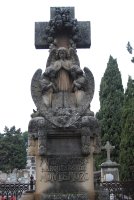4. From paths "D" and "C" to the Common Grave Path
We come back again to the Ancient Cemetery and go west along Path "D". Then we turn right northbound into the first earth trail among slender and aromatic cypresses, until the crossroads of Path "C". Here we find three magnificent pantheons made in stone at the end of the 19th century. The vaults of the families Ascaso and Moncasi (photo no 20, 1892), made by the multifaceted architect Félix Navarro, were built as a Classicist baldaquin with a big semicircular arch on each side. In contrast with its sobriety and purity of lines, the vault of the family of Antonio García Heriz (painting 28, made around 1890) is more convoluted and remembers the form of a Gothic side chapel, with many funerary symbols. More reduced and contained is the family chapel of the Marquises of Montemuzo (photo 32, 1890) with a small group of praying angels beautifully made by Buzzi and Gussoni, an Italian sculptor and ornament-maker who lived in Zaragoza.

We walk several metres along Path "C" until the crossroads with the paved path. There we find a broad trail that calls our attention because the majority of the pantheons have big crosses made in stone. An example of this typology is the vault of the Franco y López family (photo 32, 1986), with tombs placed in radial arrangement and a complexly decorated column crowned with a cross and a halo.
Now, we take this path turning right to the north. We will see simple pantheons with some interesting ornamental figures such as a Head of Christ Dead with a Crown of Thorns, a relief in marble of the sculptor Félix Burriel, inside the vault of the family Irrisarri-Villuendas (photo 44, 1930). Arriving at the crossing with the Common Grave Path (that we will follow later), we can go along to the German Cemetery, which can be seen from a metallic fence since it has an independent entry gate from the outside. Also, the modern and well-built vault of the family of the architect and painter Santiago Lagunas, made in red brick. And, finally, we can see badly conserved sculptures in cast iron (block 8, towards 1890), representing Christ on the cross and the Virgin Mary, made in the famous Averly Foundry. We come back to the Common Grave path.